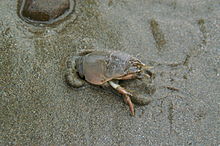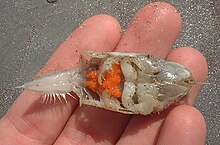Emerita (genus)
| Emerita | ||||||||||||
|---|---|---|---|---|---|---|---|---|---|---|---|---|

Female emerita analoga |
||||||||||||
| Systematics | ||||||||||||
|
||||||||||||
| Scientific name | ||||||||||||
| Emerita | ||||||||||||
| Giovanni Antonio Scopoli , 1777 |
Emerita is a small genus of decapod crabs, known colloquially as sand crabs or sand crabs. These small animals burrow in the sand below the intertidal zone and use their antennae to supply filters.
description
Emerita have a barrel-shaped body. They have a sturdy exoskeleton and can keep their limbs close to their bodies so that they can unroll in the tidal currents and waves. They have feather-like antennae that are used to filter plankton and debris from the intertidal zone .
Males are typically smaller than females, and in some species, such as Emerita Rathbunae , the tiny males live on the female's legs. Depending on the species, females are about 8–37 mm in shell length, while males vary in size from a similar size to females in E. austroafricana up to 2.5 mm in E. rathbunae and E. talpoida.
distribution
The genus as a whole is widespread in tropical and subtropical regions. Most individual species, however, are restricted to smaller areas, and their ranges rarely overlap. The genus is common on both coasts of the United States and on the Atlantic coast of Africa; the related genus Hippa is found throughout the Indo-Pacific region, including Australia.
species
Ten species are known as of 2019:
- Emerita analoga (Stimpson, 1857) - Western North America and Western South America
- Emerita austroafricana Schmitt, 1937 - Southeast Africa and Madagascar
- Emerita benedicti Schmitt, 1935 - Gulf of Mexico
- Emerita brasiliensis Schmitt, 1935 - Southeastern Brazil
- Emerita emeritus (Linnaeus, 1767) - South Asia and Southeast Asia
- Emerita holthuisi Sankolli, 1965 - West Indies, Persian Gulf and Red Sea
- Emerita karachiensis Niazi & Haque, 1974 - Pakistan
- Emerita portoricensis Schmitt, 1935 - Caribbean Sea
- Emerita rathbunae Schmitt, 1935 - Western Central America
- Emerita talpoida (Say, 1817) - East of North America
- Emerita asiatica (H. Milne Edwards, 1837) - South India
The Old World species had largely been viewed as a monophyletic group, as had the New World species. However, the use of molecular phylogenetics has shown that E. analoga, a species that lives on the Pacific coast of North America, is more closely related to African species than to other species in the New World.
Taxonomy
The genus Emerita was established by Giovanni Antonio Scopoli in his 1777 work Introductio ad Historiam Naturalem . The species was called Cancer emeritus (now E. emeritus) because it was once the only species in the genus. Other genera of the same name were rejected for nomenclature purposes; these were published by Laurens Theodorus Gronovius (1764) and Friedrich Christian Meuschen (1778 and 1781).
Ecology and behavior
Emerita is well versed in digging and is able to completely bury herself in 1.5 seconds. In contrast to mole crabs, Emerita first bury their rump in the sand and scrape it off under their body with the pereiopods. During this action, the tank is pushed into the sand as an anchorage for the digging limbs. When digging, the sand must be fluidized by wave motion, and Emerita must bury herself in the correct orientation before the wave is over to be safe from predators.
When the tide changes, Emerita changes position on the beach; most individuals stay in the breakwater zone, which can be seen from the physical properties of the sand. As the tide falls, the sand can settle; when Emerita detects this, he uses the temporary liquefaction of a breaking wave to get out of his den and is carried down the beach by the movement of the waves. The wave movement can also pull Emerita sideways along a beach.
The main predators of Emerita are fish: in the eastern Pacific, the surf perch (Amphistichus argenteus) are particularly important. Seabirds also eat emerita, but do not seem to target sand crayfish collections. Emerita's carcasses are an important source of food for the closely related scavenger Blepharipoda .
Relationship with people
Since the emerita is the predominant food of the surf bass, surf anglers use sand crabs as bait. Softshell Emerita are also used as bait in commercial fishing. In some cultures, sand crabs are eaten as a popular snack, such as in Thailand and parts of India . They are often prepared by shallow frying in the pan or deep frying in the batter. The taste is often described as falling somewhere between shrimp and crab.
Life cycle
Emerita has a short lifespan, perhaps no more than two to three years, and can reproduce in the first year of life. The eggs are bright orange and hatch into larvae that can live as plankton for more than four months and can be transported over long distances by ocean currents. The number of zoeal stages varies between six and eleven species.
Individual evidence
- ↑ Sand Fleas (Mole Crabs or Sand Crabs) Prime surf fishing bait
- ↑ http://www.baymoon.com/~ilga/crabs/ All About Mole Crabs
- ↑ a b c d Kenneth Henry Mann: Sandy beaches . In: Ecology of Coastal Waters, with Implications for Management (= Volume 8 of Studies in Ecology), 2nd. Edition, Wiley-Blackwell , 2000, ISBN 978-0-86542-550-7 , pp. 218-236.
- ↑ a b c d e f g h i Edward F. Ricketts: Open-coast sandy beaches . In: Between Pacific Tides , 5th. Edition, Stanford University Press , 1992, ISBN 978-0-8047-2068-7 , pp. 249-265.
- ↑ T. Subramoniam: Protandric hermaphroditism in a mole crab, Emerita asiatica (Decapoda: Anomura) . In: Biological Bulletin . 160, No. 1, 1981, pp. 161-174. BIOSTOR 9638 .
- ↑ a b c Pilar A. Haye: Molecular phylogenetics of mole crabs (Hippidae: Emerita ) . ( PDF ) In: Journal of Crustacean Biology . 22, No. 4, 2002, pp. 903-915. doi : 10.1651 / 0278-0372 (2002) 022 [0903: MPOMHE] 2.0.CO; 2 .
- ↑ Colin Little: The coarse extreme: life on sandy beaches . In: The Biology of Soft Shores and Estuaries . Oxford University Press , 2000, ISBN 978-0-19-850426-9 , pp. 35-57.
- ↑ a b c Christopher B. Boyko, Patsy A. McLaughlin: Annotated checklist of anomuran decapod crustaceans of the world (exclusive of the Kiwaoidea and families Chirostylidae and Galatheidae of the Galatheoidea): Part IV - Hippoidea Archived from the original on March 16, 2012 . ( PDF ) In: Zootaxa . Suppl. 23, 2010, pp. 109-129.
- ↑ Ioannis Ant. Scopoli: Introductio ad historiam naturalem sistens genera lapidum, plantarum, et animalium hactenus detecta, caracteribus essentialibus donata, in tribus divisa, subinde ad leges naturae ( Latin ). Wolfgang Gerle , Prague 1777.
- ↑ International Commission on Zoological Nomenclature: Opinion 643. Idotea Fabricius, 1798, and Mesidotea Richardson, 1905 (Crustacea, Decapoda); validation under the Plenary Powers . In: Bulletin of Zoological Nomenclature . 20, No. 1, 1963, pp. 18-25.
- ↑ a b Adolf Seilacher: Plate 21. Burrowing techniques . In: Trace Fossil Analysis . Springer , 2007, ISBN 978-3-540-47225-4 , p. 64.

